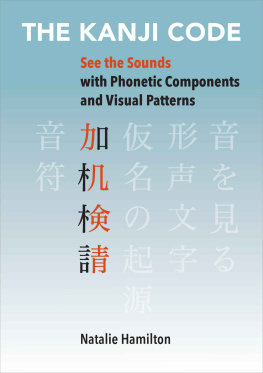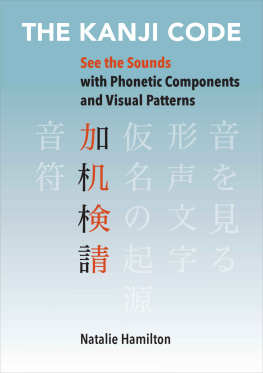Natalie Hamilton - The Kanji Code: See the Sounds with Phonetic Components and Visual Patterns
Here you can read online Natalie Hamilton - The Kanji Code: See the Sounds with Phonetic Components and Visual Patterns full text of the book (entire story) in english for free. Download pdf and epub, get meaning, cover and reviews about this ebook. year: 2019, publisher: Ocha Press, genre: Home and family. Description of the work, (preface) as well as reviews are available. Best literature library LitArk.com created for fans of good reading and offers a wide selection of genres:
Romance novel
Science fiction
Adventure
Detective
Science
History
Home and family
Prose
Art
Politics
Computer
Non-fiction
Religion
Business
Children
Humor
Choose a favorite category and find really read worthwhile books. Enjoy immersion in the world of imagination, feel the emotions of the characters or learn something new for yourself, make an fascinating discovery.
- Book:The Kanji Code: See the Sounds with Phonetic Components and Visual Patterns
- Author:
- Publisher:Ocha Press
- Genre:
- Year:2019
- Rating:4 / 5
- Favourites:Add to favourites
- Your mark:
The Kanji Code: See the Sounds with Phonetic Components and Visual Patterns: summary, description and annotation
We offer to read an annotation, description, summary or preface (depends on what the author of the book "The Kanji Code: See the Sounds with Phonetic Components and Visual Patterns" wrote himself). If you haven't found the necessary information about the book — write in the comments, we will try to find it.
So many Japanese resources mention phonetic components in passing, only offering one or two examples. It is very hard to find a definitive list of the phonetic components, as opposed to radicals which can be found in most kanji dictionaries and in multiple online resources. The Kanji Code provides that list, introducing 150 phonetic components to help you learn the ON readings of 450+ common kanji characters. The book can be used as a textbook and studied from start to finish, but it is particularly helpful as a handy reference guide, used in tandem with standard kanji textbooks.
What the reviewers said
Remembering the sounds that go with kanji can seem daunting. Hamilton has gleaned a system in which youll be seeing the sounds of kanji and accelerate your fluency in reading Japanese. I wish I had this book when I started my journey of understanding kanji. Michael Rowley, author of Kanji Pict-O-Graphix
Refreshingly different. Well worth reading, and the sort of book I wish Id had 35 years ago. -- Jim Breen, Founder WWWJDIC and Adjunct Snr Research Fellow, Japanese Studies Centre, Monash University
An invaluable resource that explains the relationship between kanji and kana, kanji and phonetic code, and kanji and visual code. I will be recommending it to my students. -- Dr Etsuko Toyoda, Asia Institute, University of Melbourne
The book provides useful background information to give you a deeper understanding of the history of kanji and the roles of the different components. It includes an easy-to-understand explanation of the keisei moji () or form-sound kanji. In addition to the phonetic components, it introduces two innovative mnemonic methods for learning kanji ON readings.
The first method is association with hiragana and katakana, which were originally based on kanji characters. The second method involves applying art theory to group similar-looking kanji. Graphics show the visual connections. The research chapter will appeal to linguistics students and Japanese teachers, while those looking for more practical tips can skip to Chapter 1, since the bulk of the book contains practical reference materials.
It will be of most use to intermediate learners who have already mastered around 300 kanji or passed N3 of the Japanese Language Proficiency Test. It will also appeal to visual learners and those who like to take a creative approach to learning. Compact and easy to carry, it is an essential companion handbook for serious kanji students.
Natalie Hamilton: author's other books
Who wrote The Kanji Code: See the Sounds with Phonetic Components and Visual Patterns? Find out the surname, the name of the author of the book and a list of all author's works by series.





![Eriko Sato - My First Japanese Kanji Book: Learning kanji the fun and easy way! [Downloadable MP3 Audio Included]](/uploads/posts/book/406403/thumbs/eriko-sato-my-first-japanese-kanji-book-learning.jpg)




















































